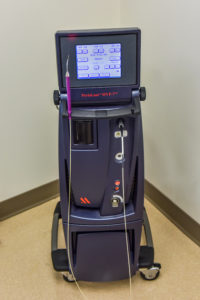Lasers in Dentistry
Lasers have been used in dentistry for many years. There are many different types which vary in the light wavelength and the intensity. Most of these lasers are useful in some aspect of dentistry. However, no one laser is good for all uses.
Safety
Dentists use lasers which have been approved for safety. But this is only part of the story.
NdYAG laser and Millenuium Dental
Over 15 years ago two dentists in California began experimenting with an Nd:YAG laser and gum disease. This laser has a wavelength of1064nm. Over a number of years they developed a protocol for treating gum disease (periodontitis). This protocol is called LANAP. Using the LANAP requires using a specific laser with the specific technique/protocol. Any person using the LANAP procedure name must be rigorously trained and use very specific equipment and techniques.
The copyright and specific procedure name is a protection to our patients against being misled by “look- a-likes”. There is a difference.
The FDA gave partial approval to the LANAP technique in 2004. Final approval with an FDA 510K level was received in March 2016. This level of approval is remarkable. There is no other regenerative technique available in periodontics with this approval.
 How does the LANAP work?
How does the LANAP work?
The objective of this technique is fundamentally different from classic treatment of periodontitis. Classic periodontal surgery is mostly resective, with occasional attempts at regeneration. As the video link shows, the objective of the LANAP procedure is not to shrink the gums as is done in classic surgery. Rather the objective is to get the gums to seal back to the tooth with repair of lost tissue.
There are therapeutic effects specific to LANAP. First, the laser removes the surface lining (epithelium) of the tissue facing the tooth. This leaves fresh (connective tissue) tissue against the tooth to facilitate healing. Second, this particular wavelength of light kills many types of bacteria which cause gum disease. Third, the wavelength also appears to stimulate the growth of new tissue.
The specific wavelength of light used is only part of the story. The protocol involves varying the setting for different effects. There is tooth cleaning and bone stimulation done with instruments. The bite is adjusted. There is also a detailed post operative management.
Who does the LANAP?
Dr. Gager is the first Periodontist in Maine to embrace the LANAP for the treatment of periodontitis. The protocol is also taught in several leading specialty training programs.
Dr. Gager is the only individual in the practice licensed to do the LANAP procedure. The visits are up to 2 ½ hours to do half of the mouth.
Individuals who have had LANAP continue to get some of their cleanings in this office. The hygiene staff uses the laser occasionally at a reduced, nonsurgical, setting.
Is LANAP covered by insurance?
To date, the procedure is covered by dental insurance to the same degree that standard osseous surgery is. This will depend on your specific insurance company. We can usually do a predetermination of benefits
Why would I want the LANAP?
There are several specific reasons why many people prefer the LANAP to standard periodontal surgery.
- The LANAP procedure is the only procedure fully approved by the FDA for regenerating/healing lost gum tissue.
- There is no cutting and sewing so there is less pain.
- There is very little, if any, exposure of more tooth unlike standard gum surgery. This means less aesthetic change, less increased sensitivity to cold, and less food caught between the teeth after treatment
There is another, more subtle reason. Periodontitis is a chronic condition not unlike arthritis or hypertension. We strive to use the least invasive/traumatic technique to control it. Resective surgery is always still available in the future.
What do we recommend?
Every case is different. After examining, Dr. Gager will make a specific recommendation on the type of treatment based on your comprehensive needs. Maine Periodontics has laser and non-laser techniques available. Our recommendations will be based on your needs rather than our capabilities.
